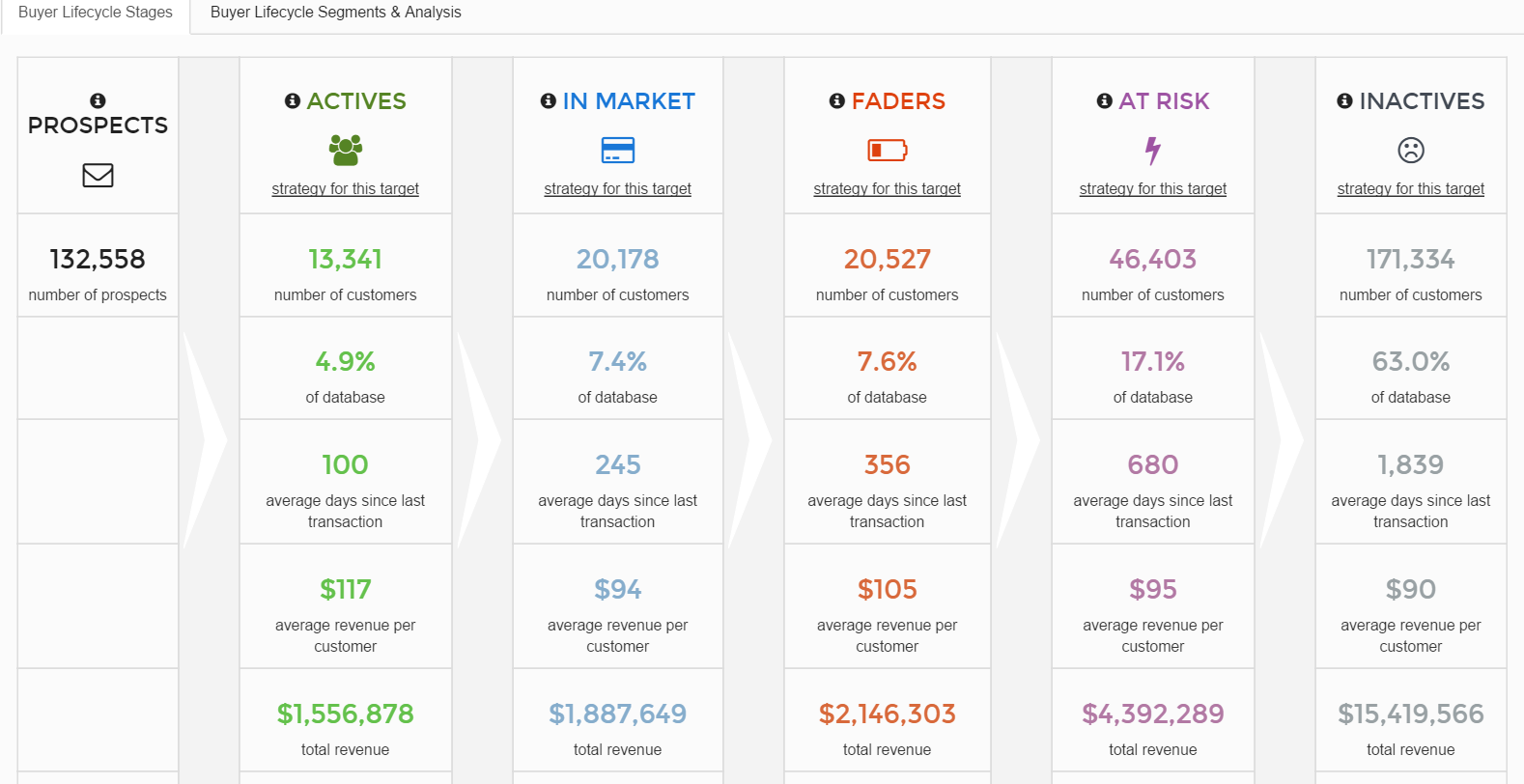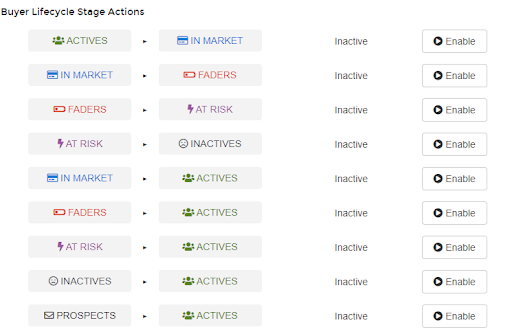The Guide to Marketing Nirvana [Step 5]
The world of marketing and advertising is changing at breakneck speed.
Programmatic advertising buys see changes in the cost of impressions from minute-to-minute. The cost of search terms rise and fall based on competitive bidding. Batch-and-blast emails are flooding inboxes.
In addition, competitive marketing dialogues with customers evolve dynamically as digital activities change the odds of customers purchasing from retailers.
So, how can a small marketing department keep pace with these factors and other dynamics that are changing the marketplace?
Predictive Marketing Automation
Today’s marketers find themselves in their own combative cyberwar with their competitors and simply need to automate as much of their activities as possible.
A key tool, then, is a Predictive Marketing Automation Platform (PMA).
A PMA accomplishes three things:
- It utilizes machine intelligence to effectively predict who is going to buy what and when.
- It detects when an individual has gone “in-market” and has a higher likelihood to spend inside a calculated purchase window.
- Once it notices the change in that consumer’s buying potential, it takes action on its own by contacting them with the right offer, at the right time.
These machine intelligence capabilities grow smarter over time as we learn how each customer responds or does not respond to various marketing actions. In order to win with customers and reach Marketing Nirvana, a PMA is an essential capability.
Recap/What’s Next
So, let’s begin with a quick recap of the steps to Marketing Nirvana that we have discussed so far in our series of blog posts:
- Enter customer data into a PMA — begin to keep comprehensive promotion and buyer history data over time.
- Understand who the customer is.
- Create Customer journeys based on value and customer purchases.
- Design email/digital campaigns to maximize sales; create a plan to test and learn over time.
Our next step in this sequence is:
- Leverage the customer’s relationship autonomously based on buying, promotion and engagement history. Enhance the customer’s journey by understanding where they are in their purchasing lifecycle and tailoring planned touches accordingly.
All customer relationships have a beginning and an end. Moreover, those relationships vary from person to person and segment to segment. Each customer has his/her own marketing genetic code℠.
While we discussed the Buyer Lifecycle in Step 2, its importance makes it worthwhile to revisit here in a little more detail.
Understanding the Buyer Lifecycle
The term Buyer Lifecycle (BLC) refers to the natural evolution of a customer/retailer relationship. It depicts your customer’s relationship and brand engagement from the moment that they become a prospect, an in-market buyer, and finally inactive.
Many customers apply recency, frequency and monetary value algorithms as a surrogate for BLC. Unfortunately, those algorithms are typically manually intensive and error prone.
Every customer has their own unique lifecycle throughout their relationship with your company. A paramount goal of your brand should be discover customer behaviors while also influencing and creating new ones.
With PMAs, these actions are swiftly automated via predictive analytics and machine intelligence. They analyze the discrete events and metrics that either drive or diminish both revenue opportunities and customer value.
The notion that any customer file or database is mostly static is a misconception. In reality, your customers’ BLC is a dynamic, ongoing process that changes every single day.
A PMA utilizes email behaviors, past purchases, web behaviors and external data sources to understand how engaged certain customers and prospects are at any given time.
| 1. Prospects |
Not yet customers. |
| 2. Actives |
Individuals currently engaged and/or spending with you. |
| 3. In Market |
Buyer currently shopping for your products and are prepared/likely to buy again |
| 4. Faders |
Subjects no longer purchasing at the rate their customer profile suggests they can. |
| 5. At Risk |
Buyers most likely to stop spending with your brand and fall into attrition. |
| 6. Inactives |
Customers who have ceased purchasing your products. |
This allows you to see exactly where your current/potential customers are by autonomously designating them into one of six distinct stages.
The Buyer Lifecycle
 Example of a Buyer Lifecycle Analytics (BuyerGenomics).
PMAs freely shift each customer among the six different stages according to a range of established variables and key signals.
These signals can include answers to the following questions:
Example of a Buyer Lifecycle Analytics (BuyerGenomics).
PMAs freely shift each customer among the six different stages according to a range of established variables and key signals.
These signals can include answers to the following questions:
- How often have they visited your website? How long since the last time?
- What did they browse? How close did they come to making a purchase?
- What are their respective buying patterns? How frequently/infrequently have they bought?
- Are they opening/clicking your messages? Or ignoring them?
- Have they made a trip to one of your stores?
BLC In Action
Due to advances in cloud computing, it is finally feasible for all marketers to maximize BLC visibility so that swift action can be taken whenever crucial shifts between stages occur.
For instance, a customer who recently shifted into the “Fading” stage requires a form of marketing intervention. This can come in the form of special discounts, privileges, gifts, or other offers that may reactivate the customer.
Meanwhile, for customers who have been labeled “Inactive” for an extended period of time, it may not make sense to waste anymore of your marketing resources on them.
On the other end, once a “Prospect” shifts to “Active,” you have your best shot at convincing them that your product is the one they want to buy not just once, but repeatedly and consistently.
Send a personalized message, and strike while the iron is hot.
Each sector of the BLC involves a different approach and strategy. Therefore, a proper grasp of its intricacies helps to understand each customer better and consistently target them with relevant information.
AutoPilot
Obviously, keeping track of customer attributes and segments is a complex task. A PMA’s AutoPilot feature helps to simplify that process and make it actionable.
AutoPilot automatically allocates messages to customers based on their journey and BLC stage. Specifically, AutoPilot identifies those customers who need to be treated differently in your marketing campaign and then automatically triggers changes to outgoing customer communications.
These changes to planned customer journeys can range from personalized offers to attention-grabbing subject lines – all customized based on the probability of success.
To activate these automated treatments, simply click on a PMA’s enable menu to automatically initiate segmentation.

Wrap-up: Your Buyer\’s Lifecycle and Automation
Buyers are the lifeblood of your business, and as is often the case, the Pareto Principle rules: 80% of profit normally comes from just 20% of your customers.
Earlier in Part 3 , we cited another compelling marketing statistic: increasing customer retention by just 5% increases profitability by 25 to 95%.
The marketing imperative is clear: Having an automated strategy to tailor messages to customers based on their buyer lifecycle and relationship with your company is the best formula to maximize customer retention and sales over time.
In our next section, we will discuss how PMA’s can help you acquire more customers through targeted acquisition strategies.
In addition, we’ll explain how competitive marketing dialogues with customers evolve dynamically as digital activities continue to alter the odds of customer purchase rates from retailers.
About the Author:
Gary’s background includes over 30 years of analytics & database innovation for several leading Fortune 500 companies and Madison Avenue advertising agencies. Gary has been a frequent lecturer and author on the topics of database marketing and applied statistics. His articles have been published in DM News, Direct Marketing and the Journal of Direct Marketing. He recently was President of the Direct Marketing Idea Exchange and served on their Board. Gary received his M.S. in Industrial Administration from Carnegie Mellon University.
Any further questions or insight? Email Gary at gbeck@buyergenomics.com.
 Example of a Buyer Lifecycle Analytics (BuyerGenomics).
PMAs freely shift each customer among the six different stages according to a range of established variables and key signals.
These signals can include answers to the following questions:
Example of a Buyer Lifecycle Analytics (BuyerGenomics).
PMAs freely shift each customer among the six different stages according to a range of established variables and key signals.
These signals can include answers to the following questions:






